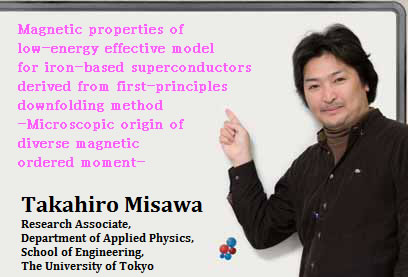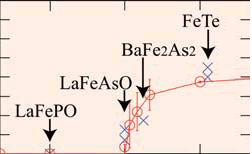Magnetic properties of low-energy effective model for iron-based superconductors derived from first-principles downfolding method ‒Microscopic origin of diverse magnetic ordered moment‒
 One of the central issues in recent solid-state physics is a strongly-correlated electron system where energy scales of interactions among electrons become comparable to those of band widths. In this system, it is known that the strong interactions among electrons induce many intriguing phenomena such as high-temperature superconducting phase.
One of the central issues in recent solid-state physics is a strongly-correlated electron system where energy scales of interactions among electrons become comparable to those of band widths. In this system, it is known that the strong interactions among electrons induce many intriguing phenomena such as high-temperature superconducting phase.
It is one of the most important objectives of solid-state physics research to understand these intriguing phenomena from the "first-principles Hamiltonian" in solids, namely, the Hamiltonian that includes the periodic potential created by atoms and the Coulomb interaction among electrons. Because of huge degrees of freedom in the first-principles Hamiltonian, it is impossible to solve this Hamiltonian exactly even with the largest and fastest supercomputers that exist today. For this difficulty, up to now, many researchers have focused on the low-energy part of the system and derive low-energy effective model that reproduces intriguing phenomena observed in solids. Although this method h a s s u c c e e d e d i n e x p l a i n i n g m a n y intriguing phenomena in solids, in most cases the parameters of the effective model were determined "by hand," and its validity of these parameters is unclear and under hot debates. In recent years, we developed "first-principles downfolding method" as a bridge linking the first-principles Hamiltonian and the effective model. In this method, first, we calculate global band structures of solids based on the first-principles Hamiltonian. Then, in order to derive a low-energy effective model, we eliminate the degrees of freedom in the high-energy part, which is away from the Fermi energy, by using constrained random phase approximation. By using this method, without a priori hypothesis, we can determine the parameters of the effective model only from the structures of solids. By analyzing this effective model with high accuracy numerical calculation methods such as multivariable variational Monte Carlo method, we can clarify and predict the electronic properties of solids. In this study, we apply this method t o r e c e n t l y d i s c o v e r e d i r o n - b a s e d superconductors. We have shown that differences in interaction parameters induce the diverse magnetic properties of the iron-based superconductors (see figure). This is the first study to clarify the microscopic origins of these diverse magnetic properties from first-principles calculations.

Comparison between theoretical magnetic ordering moments m(qpeak) (red circles), and experimental values (blue Xs). The horizontal axis represents the scaling parameter λ that
uniformly scales the interaction parameters. Our theoretical results are in excellent agreement with experiment.



